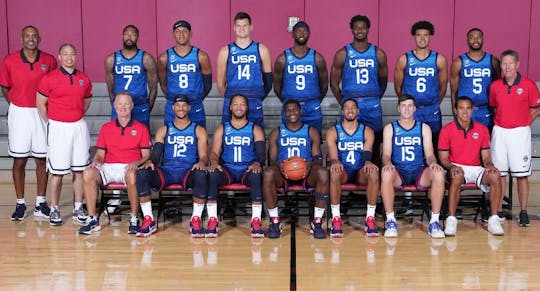In the 2019 FIBA World Cup, the United States of America finished 7th which was their lowest in their history. This team was coached by Hall of Fame coach Gregg Popovich and had NBA superstars such as Jayson Tatum, Donovan Mitchell, Jaylen Brown, Kemba Walker, and Khris Middleton. The lineup they had for 2019 was not weak by any means but lacked the tier-one, superstar talent that we are accustomed to be associated with Team USA (like LeBron James or Kobe Bryant). For the 2023 edition and with only the gold as their target, the US has again managed to put up a very solid roster. But will it be enough to win?
Most people were saddened after multiple superstars and All-Stars backed out of Team USA like Tatum, Kevin Durant, and Stephen Curry just to name a few of the eligible players. The squad that they ended up forming does contain a couple of All-Stars, some really good role players, and borderline All-Stars. But when you expect other countries to bring in the best of the best, is there such thing as good enough? We saw it last time when the US finished 7th.
However, there is an advantage in this type of lineup. With superstars in the lineup, the scheme is more often than not catered to them. It also makes it difficult for some players as they try and tiptoe around to find their spot. Not having stars allows other players to step up and find their own space without fear that they are stepping over their superstars. The lineup Team USA also managed to form is quite flexible and allows for head coach Steve Kerr to adapt to their style of play. They want to play more uptempo, put Tyrese Haliburton at point, and go smaller with Jaren Jackson Jr. or Paolo Banchero at center. They want to put a defensive five out there and there are multiple options to choose from. Having a superstar allows a team to walk on the floor with confidence that they have the best player, but the roster the US made now is competitive as it allows for coaching to shine and become creative.
Still, people wondered who was going to be the main guy for the Americans – the one who would take over the game and the one the team would go to if they needed a basket. Arguably, a lot of guys on the team have the talent to do so, but only one can claim that title. In previous iterations, it was more or less clear who was going to be that guy as the team had multiple options to choose from like the 2014 USA squad that had James Harden, Stephen Curry, Anthony Davis, Derrick Rose, and Kyrie Irving.
This team found its answer throughout the tune-ups. Anthony Edwards is “him.” In all of the games, he has been one, if not the top-scorer for the United States. He dropped a 15-piece against Slovenia and Puerto Rico, a 21-point barrage against Greece, and topped off with a massive 34-point explosion in a come-from-behind win against Germany. It seems that he is ready to take the next step in his journey to superstardom. His last NBA season saw career-high averages in most categories in only his junior season. He looks poised to be him for this United States squad.
Another issue that people have with this USA squad is the lack of size. Theoretically, the US has one of the longest squads and has a good size throughout their backcourt. They only have one traditional big in their roster in Walker Kessler. The other bigs, Bobby Portis, Jaren Jackson Jr., Paolo Banchero, and Brandon Ingram, fit the more modern mold with the ability to switch, defend the perimeter, and hit the 3-point shot. Some analysts have questioned if having one traditional big is enough especially with the grueling schedule and physicality of the tournament. I do believe, however, that the US has great size to compete, especially if you look at their other spots. The team also has the ability to make up for the lack of traditional size using their quickness, length, athleticism, and game plan. In their friendlies, it was evident that they would use their pressure-style defense, in combination with their physical tools to make it difficult for opponents to overwhelm them. Remember, FIBA courts are smaller than NBA courts, which means that all the gaps and space that the US would normally fail to cover in the NBA, are gone. Open windows to shoot much faster. Help side defenses are one step nearer and it makes all the difference for the US. Plus, if you look at the coaching staff they brought, Steve Kerr and Erik Spoelstra, they are masters in creating defensive schemes with smaller and more aggressive lineups.
People also question the inexperience of this team. Compared to other countries, the US is partially young with the eldest players being Josh Hart and Bobby Portis at 28, which is the average age of most teams. Most of these players also haven’t played FIBA rules basketball. How are they going to adjust to the physicality, the officiating, the new rules, and the smaller court? Some members of the roster have played on the international stage in their youth days, but this will be the first time for most of them in the seniors’ rank. Watching the earlier friendlies, it was evident that the team needed time to jell and get adjusted to the new rules. However, they seemed to get more comfortable with one another and playing the international game. And as professional athletes, their job is to adapt to any situation they are put in.
In spite of all the questions that people have regarding Team USA’s road to the goal, I still believe that they are the favorites. A lot of people may pick Slovenia, Spain, France, or maybe even Canada or Germany to win it all, but it is always tough to bet against the United States.




